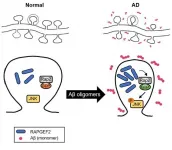(Press-News.org) Freshwater is accumulating in the Arctic Ocean. The Beaufort Sea, which is the largest Arctic Ocean freshwater reservoir, has increased its freshwater content by 40% over the past two decades. How and where this water will flow into the Atlantic Ocean is important for local and global ocean conditions.
A study from the University of Washington, Los Alamos National Laboratory and the National Oceanic and Atmospheric Administration shows that this freshwater travels through the Canadian Archipelago to reach the Labrador Sea, rather than through the wider marine passageways that connect to seas in Northern Europe. The open-access study was published Feb. 23 in Nature Communications.
"The Canadian Archipelago is a major conduit between the Arctic and the North Atlantic," said lead author Jiaxu Zhang, a UW postdoctoral researcher at the Cooperative Institute for Climate, Ocean and Ecosystem Studies. "In the future, if the winds get weaker and the freshwater gets released, there is a potential for this high amount of water to have a big influence in the Labrador Sea region."
The finding has implications for the Labrador Sea marine environment, since Arctic water tends to be fresher but also rich in nutrients. This pathway also affects larger oceanic currents, namely a conveyor-belt circulation in the Atlantic Ocean in which colder, heavier water sinks in the North Atlantic and comes back along the surface as the Gulf Stream. Fresher, lighter water entering the Labrador Sea could slow that overturning circulation.
"We know that the Arctic Ocean has one of the biggest climate change signals," said co-author Wei Cheng at the UW-based Cooperative Institute for Climate, Ocean and Atmosphere Studies. "Right now this freshwater is still trapped in the Arctic. But once it gets out, it can have a very large impact."
Fresher water reaches the Arctic Ocean through rain, snow, rivers, inflows from the relatively fresher Pacific Ocean, as well as the recent melting of Arctic Ocean sea ice. Fresher, lighter water floats at the top, and clockwise winds in the Beaufort Sea push that lighter water together to create a dome.
When those winds relax, the dome will flatten and the freshwater gets released into the North Atlantic.
"People have already spent a lot of time studying why the Beaufort Sea freshwater has gotten so high in the past few decades," said Zhang, who began the work at Los Alamos National Laboratory. "But they rarely care where the freshwater goes, and we think that's a much more important problem."
Using a technique Zhang developed to track ocean salinity, the researchers simulated the ocean circulation and followed the Beaufort Sea freshwater's spread in a past event that occurred from 1983 to 1995.
Their experiment showed that most of the freshwater reached the Labrador Sea through the Canadian Archipelago, a complex set of narrow passages between Canada and Greenland. This region is poorly studied and was thought to be less important for freshwater flow than the much wider Fram Strait, which connects to the Northern European seas.
In the model, the 1983-1995 freshwater release traveled mostly along the North American route and significantly reduced the salinities in the Labrador Sea -- a freshening of 0.2 parts per thousand on its shallower western edge, off the coast of Newfoundland and Labrador, and of 0.4 parts per thousand inside the Labrador Current.
The volume of freshwater now in the Beaufort Sea is about twice the size of the case studied, at more than 23,300 cubic kilometers, or more than 5,500 cubic miles. This volume of freshwater released into the North Atlantic could have significant effects. The exact impact is unknown. The study focused on past events, and current research is looking at where today's freshwater buildup might end up and what changes it could trigger.
"A freshwater release of this size into the subpolar North Atlantic could impact a critical circulation pattern, called the Atlantic Meridional Overturning Circulation, which has a significant influence on Northern Hemisphere climate," said co-author Wilbert Weijer at Los Alamos National Lab.
INFORMATION:
This research was funded by the Department of Energy, the National Science Foundation, Los Alamos National Laboratory, and NOAA. Other authors are Mike Steele at the UW Applied Physics Laboratory and Tarun Verma and Milena Veneziani at Los Alamos National Lab.
For more information, contact Zhang at jiaxuzh@uw.edu.
Emerging smart mobile health (or mHealth) technologies are changing the way patients track information related to diagnosed conditions. A new study examined the health and economic impacts of mHealth technologies on the outcomes of diabetes patients in Asia. The study concluded that compared to patients who did not use mHealth applications, patients who used the apps had better health outcomes and were able to regulate their health behavior more effectively. They also had fewer hospital visits and lower medical costs.
The study was conducted by researchers at Carnegie Mellon University (CMU) and New York University ...
New Orleans, LA -- A new study of how the 2020 major hurricanes and the COVID-19 pandemic affected each other as well as disaster response found that although prior experience enabled community-based organizations to respond to the pandemic, the pandemic is also creating new challenges to preparing for and responding to natural disasters. The research is published in the International Journal of Environmental Research and Public Health, available here.
"Two major crises hit Louisiana and coastal communities in the Southeastern United States in 2020 - a significant increase in the frequency and severity of hurricanes, and the COVID-19 pandemic," says Benjamin Springgate, MD, MPH, Chief of Community & Population Medicine at ...
A study aiming to develop a new therapeutic technique could bring a revolution in our approach to treating rare, fatal Sanfilippo syndrome, a disorder that affects children as young as 2 years old and leads to childhood dementia and premature death.
"We are using a combination of gene therapy, stem cells and small molecules to restore metabolic defects in the patient's brain cells" says Dr. Alexey Pshezhetsky, Professor at CHU Ste-Justine and lead GlycoNet Investigator on this project. "First results in the mouse models of the disease are very encouraging."
Sanfilippo syndrome belongs to a group of rare diseases known as lysosomal storage disorders.
The syndrome occurs in ...
ITHACA, N.Y. - During mating season, male bearded seals make loud calls to attract a mate. How loud? Well, even their "quiet" call can still be as ear-rattling as a chainsaw.
These elaborate vocalizations are essential for bearded seal reproduction, and have to be loud enough to be heard over the cacophony of their equally loud brethren.
But in the rapidly changing Arctic soundscape, where noise from industrial activities is predicted to dramatically increase in the next 15 years, bearded seals may need to adjust their calling behavior if they are ...
Washington, DC - February 24, 2021 - In the absence of effective treatments for COVID-19, many countries have approved the therapeutic use of blood plasma from recovering patients because it contains antibodies against the coronavirus. But not every type of antibody can neutralize the virus and render it noninfectious. New research published this week in mSphere, an open-access journal of the American Society for Microbiology, explores variation in virus neutralization capabilities, which can vary widely by type of antibody.
"What we need for plasma therapy is not only high levels of antibodies but also high neutralization capability," said virologist Michael Schindler, Ph.D, at University Hospital Tübingen, ...
X-rays are used to study the atomic and microstructure properties of matter. Such studies are conducted with special accelerator complexes called synchrotrons. A synchrotron source generates powerful electromagnetic radiation with a wavelength equal to fractions of a nanometer. Some X-rays are reflected from the atomic planes of a crystal and some go through the crystal plane that plays the role of a beam-splitter (or the so-called semitransparent mirror). If the radiation passes through monochromators-optical devices that consist of two or more ideal crystals - its optimal exit wavelength can be regulated. ...
Researchers have developed a data transfer system that can transmit information 10 times faster than a USB. The new link pairs high-frequency silicon chips with a polymer cable as thin a strand of hair. The system may one day boost energy efficiency in data centers and lighten the loads of electronics-rich spacecraft.
The research was presented at this month's IEEE International Solid-State Circuits Conference. The lead author is Jack Holloway '03, MNG '04, who completed his PhD in MIT's Department of Electrical Engineering and Computer Science (EECS) last fall and currently works for Raytheon. Co-authors include Ruonan Han, associate professor and Holloway's PhD adviser in EECS, and Georgios Dogiamis, ...
Korea Brain Research Institute (KBRI, Pann-Ghill Suh (President)) announced that Dr. Kea Joo Lee and Dr. You-Na Jang of the Neural Circuits Research Group have identified the mechanism causing synaptic loss in Alzheimer's disease as the aberrant expression of RAPGEF2, a synaptic protein.
- The results were published on January 2021, in the online Early View of Neuropathology and Applied Neurobiology.
* (Title) RAPGEF2 mediates oligomeric Aβ-induced synaptic loss and cognitive dysfunction in the 3xTg-AD mouse model of Alzheimer's disease
Alzheimer's disease (AD) accounts for about 75% of dementia cases and is the most common type of degenerative brain disease. AD is a devastating because disease progression can cause ...
Chemical & Engineering News (C&EN), the newsmagazine of the American Chemical Society (ACS), is celebrating Black chemists and chemical engineers with a special issue highlighting Black chemists who work across the fields of biotechnology, solar energy, pharmaceuticals and more. Guest edited by Massachusetts Institute of Technology (MIT) drug delivery pioneer Paula Hammond, Ph.D., this special issue showcases Black scientists, spotlighting their scientific passions and career accomplishments.
"In bringing into focus the unique lives of this set of accomplished Black scientists in chemistry and chemical engineering, ...
The steadily increasing prevalence and high costs of treating chronic joint pain worldwide poses a challenge for healthcare systems and healthcare payers. New research published today in END ...


